What is Hadchoseitf.work?
Hadchoseitf.work is a website which uses social engineering to fool unsuspecting users into subscribing push notifications from malicious (ad) push servers. Although push notifications cannot harm users directly, scammers use them to display annoying ads, promote fake software, and encourage users to visit shady web-pages.
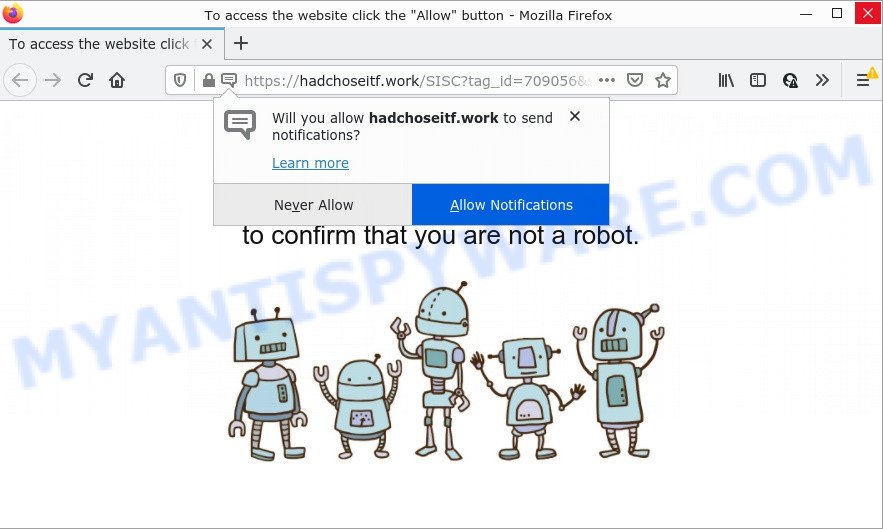
When you visit the Hadchoseitf.work web site that wants to send you push notifications, you will be greeted with a confirmation request that asks whether you want to agree to them or not. Your options will be ‘Block’ and ‘Allow’. If you click the ‘Allow’ button, then your web-browser will be configured to display pop-up ads in the bottom right corner of Windows or Mac.

Threat Summary
| Name | Hadchoseitf.work pop up |
| Type | spam push notifications, browser notification spam, pop-up virus |
| Distribution | suspicious pop up ads, potentially unwanted programs, adware, social engineering attack |
| Symptoms |
|
| Removal | Hadchoseitf.work removal guide |
Where the Hadchoseitf.work pop ups comes from
Cyber threat analysts have determined that users are re-directed to Hadchoseitf.work by adware software or from dubious ads. Adware is a type of harmful applications that can display unwanted ads, alter web browser settings, download and install harmful browser plugins. All the time, while adware is running, your web-browser will be fill with annoying advertisements. Most probably, adware has been installed on your computer without your’s knowledge and you do not even know how and where adware has got into your PC.
The most common way to get adware is a freeware installer. In most cases, a user have a chance to disable all bundled modules, but certain setup files are designed to confuse the average users, in order to trick them into installing potentially unwanted programs and adware software. Anyway, easier to prevent adware rather than clean up your PC after one. So, keep your web browser updated (turn on automatic updates), run good antivirus programs, double check free software before you open it (do a google search, scan a downloaded file with VirusTotal), avoid suspicious and unknown web-pages.
Remove Hadchoseitf.work notifications from browsers
Your browser likely now allows the Hadchoseitf.work webpage to send you push notifications, but you do not want the annoying advertisements from this webpage and we understand that. We have put together this tutorial on how you can remove Hadchoseitf.work popups from Google Chrome, Safari, Android, Firefox, Internet Explorer and Edge.
Google Chrome:
- Just copy and paste the following text into the address bar of Chrome.
- chrome://settings/content/notifications
- Press Enter.
- Remove the Hadchoseitf.work URL and other rogue notifications by clicking three vertical dots button next to each and selecting ‘Remove’.
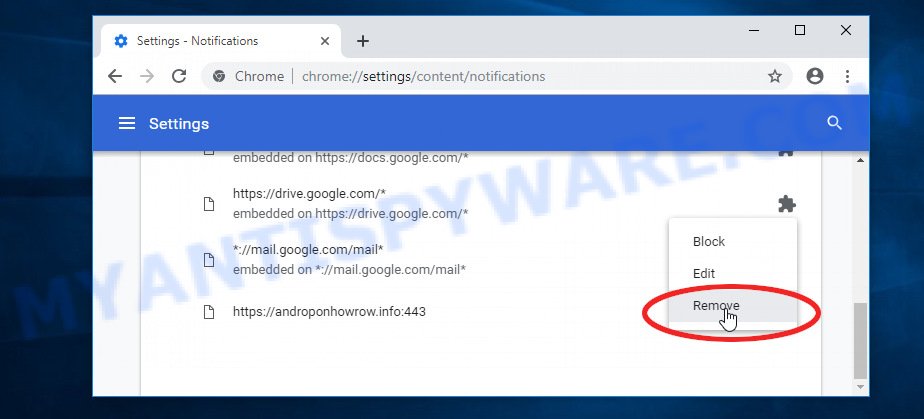
Android:
- Tap ‘Settings’.
- Tap ‘Notifications’.
- Find and tap the web-browser which displays Hadchoseitf.work browser notifications ads.
- Find Hadchoseitf.work site in the list and disable it.
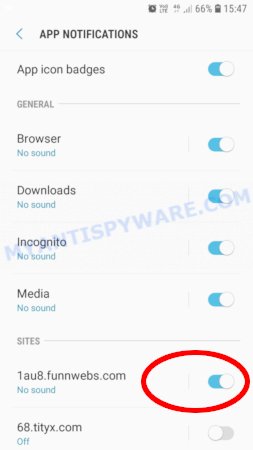
Mozilla Firefox:
- Click the Menu button (three horizontal stripes) on the top-right corner of the browser.
- Choose ‘Options’ and click on ‘Privacy & Security’ on the left hand side of the screen.
- Scroll down to ‘Permissions’ and then to ‘Settings’ next to ‘Notifications’.
- Select the Hadchoseitf.work domain from the list and change the status to ‘Block’.
- Click ‘Save Changes’ button.
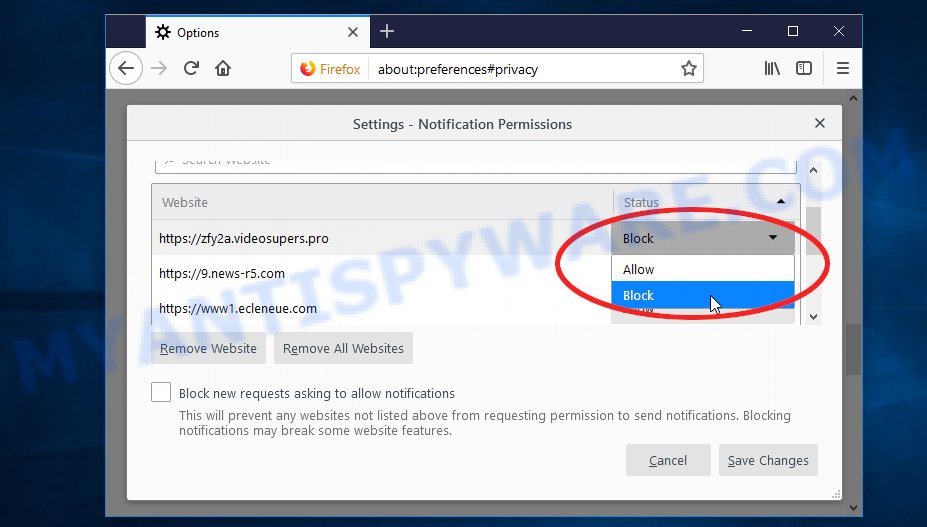
Edge:
- In the top right corner, click on the three dots to expand the Edge menu.
- Click ‘Settings’. Click ‘Advanced’ on the left side of the window.
- In the ‘Website permissions’ section click ‘Manage permissions’.
- Disable the on switch for the Hadchoseitf.work URL.
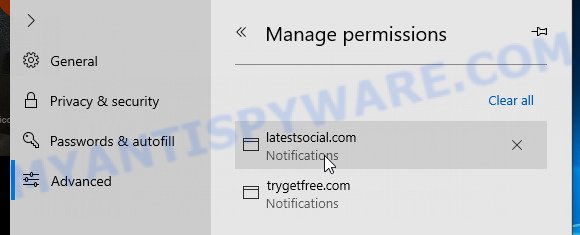
Internet Explorer:
- Click the Gear button on the top right corner of the window.
- Go to ‘Internet Options’ in the menu.
- Select the ‘Privacy’ tab and click ‘Settings below ‘Pop-up Blocker’ section.
- Select the Hadchoseitf.work URL and other dubious URLs below and delete them one by one by clicking the ‘Remove’ button.
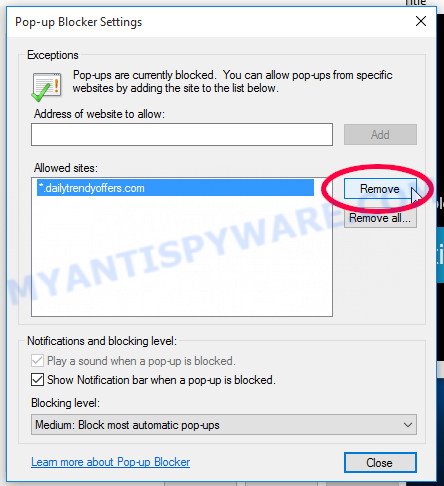
Safari:
- Go to ‘Preferences’ in the Safari menu.
- Select the ‘Websites’ tab and then select ‘Notifications’ section on the left panel.
- Check for Hadchoseitf.work domain, other suspicious URLs and apply the ‘Deny’ option for each.
How to remove Hadchoseitf.work pop-ups from Chrome, Firefox, IE, Edge
The adware is a form of malware that you might have difficulty in removing it from your personal computer. Thankfully, you’ve found the effective Hadchoseitf.work pop-up advertisements removal guidance in this post. Both the manual removal solution and the automatic removal method will be provided below and you can just choose the one that best for you. If you have any questions or need assist then type a comment below. Read this manual carefully, bookmark it or open this page on your smartphone, because you may need to exit your web-browser or restart your computer.
To remove Hadchoseitf.work pop ups, complete the following steps:
- Remove Hadchoseitf.work notifications from browsers
- Manual Hadchoseitf.work pop-ups removal
- Automatic Removal of Hadchoseitf.work popup advertisements
- Stop Hadchoseitf.work popups
Manual Hadchoseitf.work pop-ups removal
In most cases, it is possible to manually get rid of Hadchoseitf.work pop-ups. This way does not involve the use of any tricks or removal tools. You just need to recover the normal settings of the PC and web-browser. This can be done by following a few simple steps below. If you want to quickly delete Hadchoseitf.work pop-up ads, as well as perform a full scan of your PC, we recommend that you run adware software removal tools, which are listed below.
Uninstall adware software through the MS Windows Control Panel
You can manually remove most nonaggressive adware by removing the application that it came with or removing the adware itself using ‘Add/Remove programs’ or ‘Uninstall a program’ option in Microsoft Windows Control Panel.
Windows 8, 8.1, 10
First, click Windows button

After the ‘Control Panel’ opens, click the ‘Uninstall a program’ link under Programs category as shown in the figure below.

You will see the ‘Uninstall a program’ panel as shown in the figure below.

Very carefully look around the entire list of programs installed on your device. Most likely, one of them is the adware that causes multiple annoying pop ups. If you have many programs installed, you can help simplify the search of malicious applications by sort the list by date of installation. Once you’ve found a questionable, unwanted or unused program, right click to it, after that click ‘Uninstall’.
Windows XP, Vista, 7
First, click ‘Start’ button and select ‘Control Panel’ at right panel as on the image below.

After the Windows ‘Control Panel’ opens, you need to press ‘Uninstall a program’ under ‘Programs’ as displayed on the screen below.

You will see a list of apps installed on your personal computer. We recommend to sort the list by date of installation to quickly find the apps that were installed last. Most likely, it is the adware that causes Hadchoseitf.work advertisements in your web browser. If you’re in doubt, you can always check the program by doing a search for her name in Google, Yahoo or Bing. When the application which you need to delete is found, simply press on its name, and then click ‘Uninstall’ as shown on the image below.

Delete Hadchoseitf.work pop-up ads from Internet Explorer
By resetting IE web-browser you restore your web browser settings to its default state. This is first when troubleshooting problems that might have been caused by adware which causes popups.
First, run the Microsoft Internet Explorer. Next, click the button in the form of gear (![]() ). It will open the Tools drop-down menu, press the “Internet Options” as shown on the screen below.
). It will open the Tools drop-down menu, press the “Internet Options” as shown on the screen below.

In the “Internet Options” window click on the Advanced tab, then click the Reset button. The Internet Explorer will open the “Reset Internet Explorer settings” window as displayed in the figure below. Select the “Delete personal settings” check box, then click “Reset” button.

You will now need to reboot your computer for the changes to take effect.
Remove Hadchoseitf.work pop-up ads from Firefox
Resetting your Firefox is first troubleshooting step for any issues with your web browser application, including the redirect to Hadchoseitf.work web-site. However, your saved passwords and bookmarks will not be changed or cleared.
First, run the Firefox and press ![]() button. It will display the drop-down menu on the right-part of the internet browser. Further, click the Help button (
button. It will display the drop-down menu on the right-part of the internet browser. Further, click the Help button (![]() ) as displayed on the image below.
) as displayed on the image below.

In the Help menu, select the “Troubleshooting Information” option. Another way to open the “Troubleshooting Information” screen – type “about:support” in the web-browser adress bar and press Enter. It will open the “Troubleshooting Information” page such as the one below. In the upper-right corner of this screen, click the “Refresh Firefox” button.

It will display the confirmation prompt. Further, press the “Refresh Firefox” button. The Mozilla Firefox will start a procedure to fix your problems that caused by the Hadchoseitf.work adware software. When, it is complete, click the “Finish” button.
Remove Hadchoseitf.work pop-up advertisements from Chrome
Annoying Hadchoseitf.work pop ups or other symptom of having adware in your web browser is a good reason to reset Google Chrome. This is an easy method to restore the Chrome settings and not lose any important information.
Open the Chrome menu by clicking on the button in the form of three horizontal dotes (![]() ). It will open the drop-down menu. Select More Tools, then click Extensions.
). It will open the drop-down menu. Select More Tools, then click Extensions.
Carefully browse through the list of installed extensions. If the list has the add-on labeled with “Installed by enterprise policy” or “Installed by your administrator”, then complete the following instructions: Remove Google Chrome extensions installed by enterprise policy otherwise, just go to the step below.
Open the Chrome main menu again, click to “Settings” option.

Scroll down to the bottom of the page and click on the “Advanced” link. Now scroll down until the Reset settings section is visible, like below and click the “Reset settings to their original defaults” button.

Confirm your action, click the “Reset” button.
Automatic Removal of Hadchoseitf.work popup advertisements
The manual tutorial above is tedious to use and can not always help to completely get rid of the Hadchoseitf.work pop-up advertisements. Here I am telling you an automatic solution to remove this adware software from your PC completely. Zemana Anti Malware, MalwareBytes and Hitman Pro are antimalware utilities that have the ability to scan for and delete all kinds of malicious software including adware that causes multiple annoying pop ups.
Get rid of Hadchoseitf.work ads with Zemana Free
Zemana Free is a malicious software scanner that is very useful for detecting and uninstalling adware which causes popups. The steps below will explain how to download, install, and use Zemana Free to scan and remove malware, spyware, adware software, potentially unwanted programs, hijackers from your personal computer for free.

- Installing the Zemana Free is simple. First you’ll need to download Zemana AntiMalware (ZAM) by clicking on the link below. Save it on your Desktop.
Zemana AntiMalware
164818 downloads
Author: Zemana Ltd
Category: Security tools
Update: July 16, 2019
- At the download page, click on the Download button. Your browser will show the “Save as” prompt. Please save it onto your Windows desktop.
- Once the download is finished, please close all apps and open windows on your computer. Next, start a file called Zemana.AntiMalware.Setup.
- This will run the “Setup wizard” of Zemana AntiMalware (ZAM) onto your computer. Follow the prompts and don’t make any changes to default settings.
- When the Setup wizard has finished installing, the Zemana Anti Malware (ZAM) will run and show the main window.
- Further, click the “Scan” button . Zemana program will scan through the whole computer for the adware software that causes Hadchoseitf.work ads. A system scan can take anywhere from 5 to 30 minutes, depending on your computer. While the Zemana AntiMalware application is scanning, you may see how many objects it has identified as threat.
- After the scan get completed, Zemana AntiMalware will show a list of found items.
- Review the scan results and then click the “Next” button. The utility will begin to remove adware software responsible for Hadchoseitf.work pop up ads. When that process is done, you may be prompted to restart the PC.
- Close the Zemana Free and continue with the next step.
Remove Hadchoseitf.work popups and harmful extensions with Hitman Pro
Hitman Pro is a free program that developed to remove malware, PUPs, browser hijackers and adware software from your computer running MS Windows 10, 8, 7, XP (32-bit and 64-bit). It’ll help to find and delete adware that causes multiple intrusive pop ups, including its files, folders and registry keys.
Installing the Hitman Pro is simple. First you’ll need to download HitmanPro on your MS Windows Desktop from the link below.
Once downloading is done, open the folder in which you saved it and double-click the Hitman Pro icon. It will start the HitmanPro tool. If the User Account Control dialog box will ask you want to start the application, click Yes button to continue.

Next, click “Next” to look for adware software responsible for Hadchoseitf.work pop-ups. A scan can take anywhere from 10 to 30 minutes, depending on the number of files on your PC system and the speed of your device. While the HitmanPro application is scanning, you may see how many objects it has identified as threat.
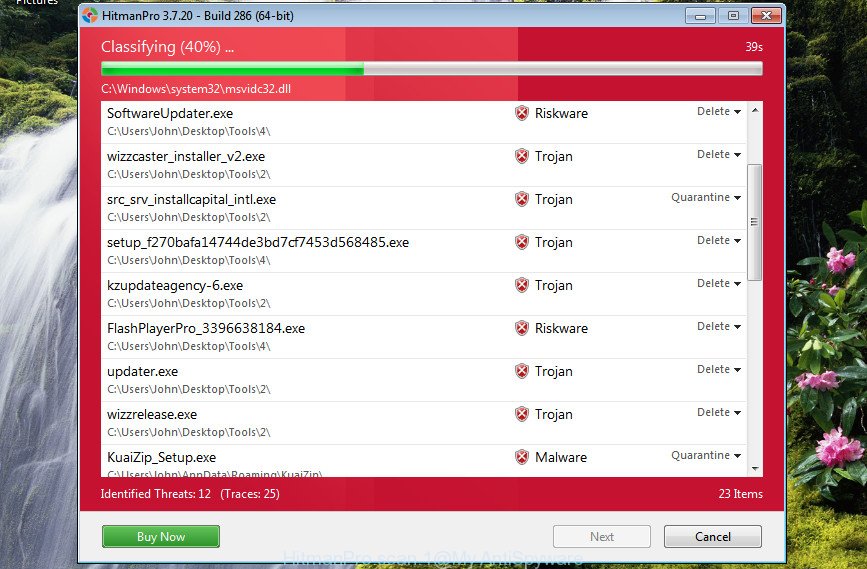
When Hitman Pro is finished scanning your personal computer, a list of all threats found is prepared as shown in the figure below.
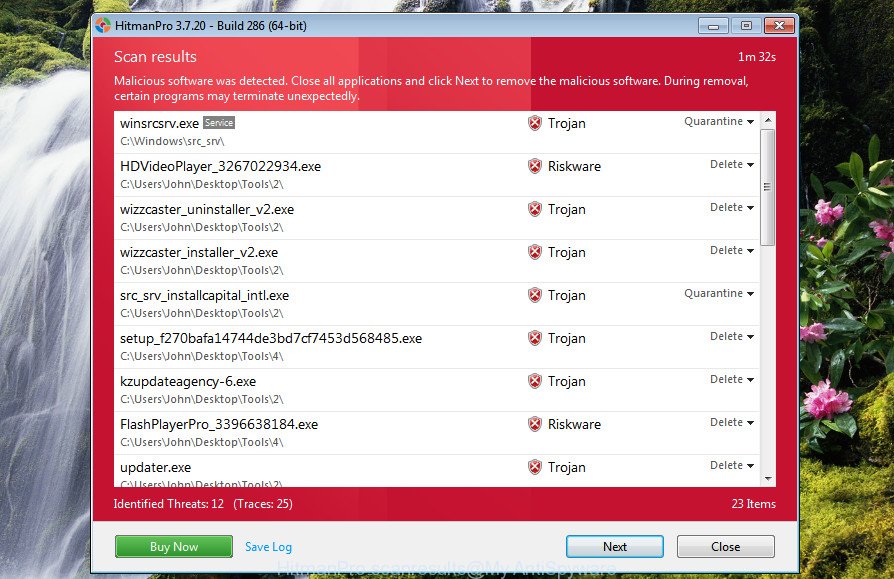
All detected items will be marked. You can delete them all by simply click “Next” button. It will show a prompt, click the “Activate free license” button. The Hitman Pro will remove adware responsible for Hadchoseitf.work advertisements and move the selected items to the Quarantine. Once disinfection is complete, the tool may ask you to reboot your PC.
Use MalwareBytes to remove Hadchoseitf.work ads
Manual Hadchoseitf.work advertisements removal requires some computer skills. Some files and registry entries that created by the adware may be not fully removed. We suggest that run the MalwareBytes that are completely clean your computer of adware software. Moreover, the free program will help you to delete malware, PUPs, hijackers and toolbars that your computer can be infected too.
Visit the following page to download the latest version of MalwareBytes AntiMalware for Windows. Save it directly to your MS Windows Desktop.
327077 downloads
Author: Malwarebytes
Category: Security tools
Update: April 15, 2020
When downloading is done, close all apps and windows on your PC system. Double-click the install file called MBSetup. If the “User Account Control” dialog box pops up as displayed on the screen below, click the “Yes” button.
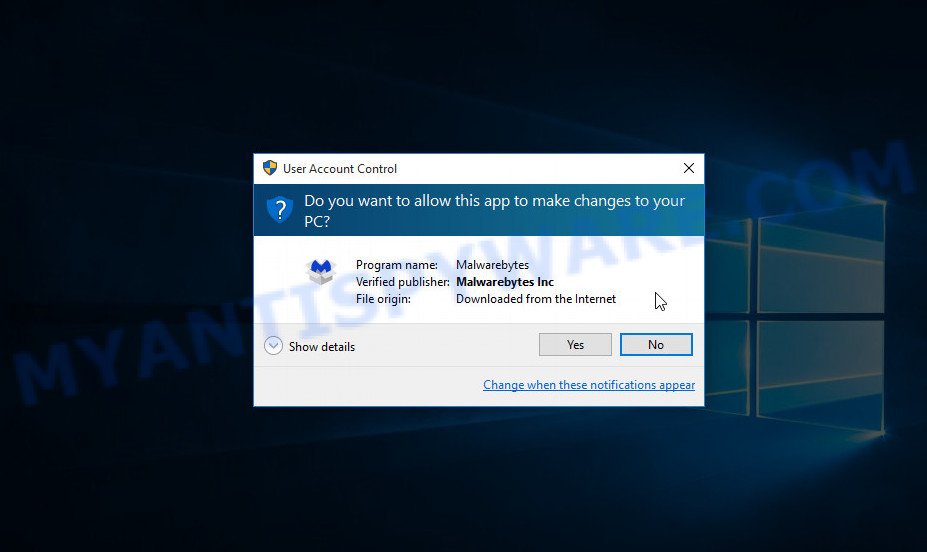
It will open the Setup wizard which will help you install MalwareBytes Free on your computer. Follow the prompts and do not make any changes to default settings.
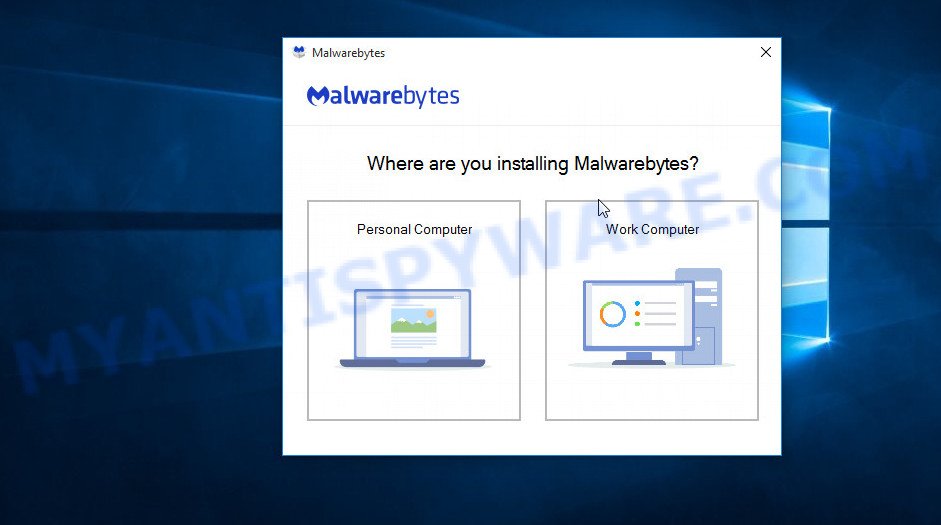
Once install is complete successfully, click “Get Started” button. MalwareBytes will automatically start and you can see its main screen like below.
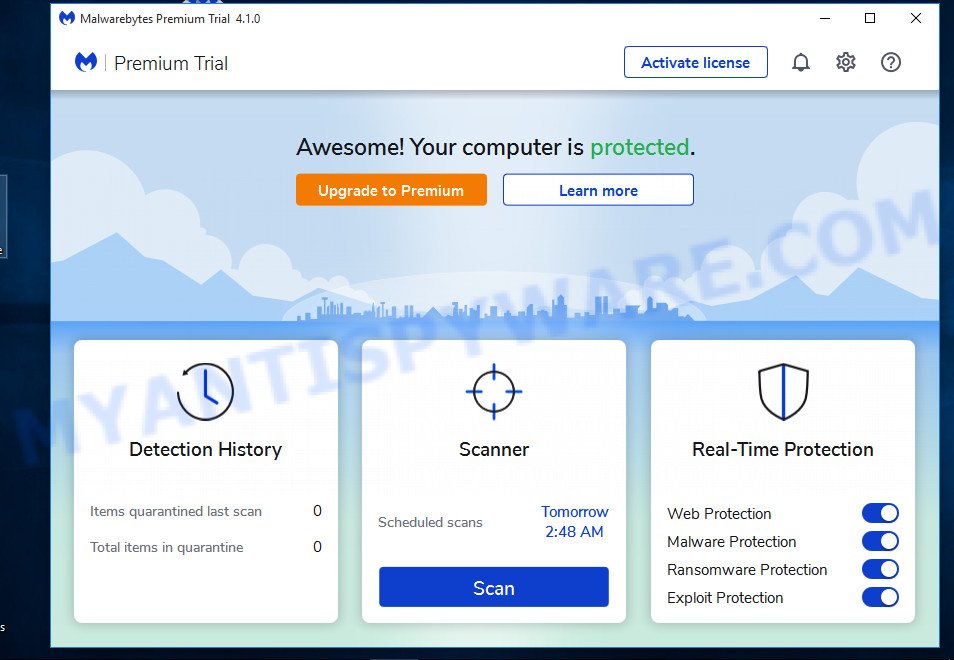
Now click the “Scan” button for scanning your computer for the adware that causes multiple unwanted pop-ups. This procedure can take some time, so please be patient. While the MalwareBytes AntiMalware is scanning, you may see how many objects it has identified either as being malware.
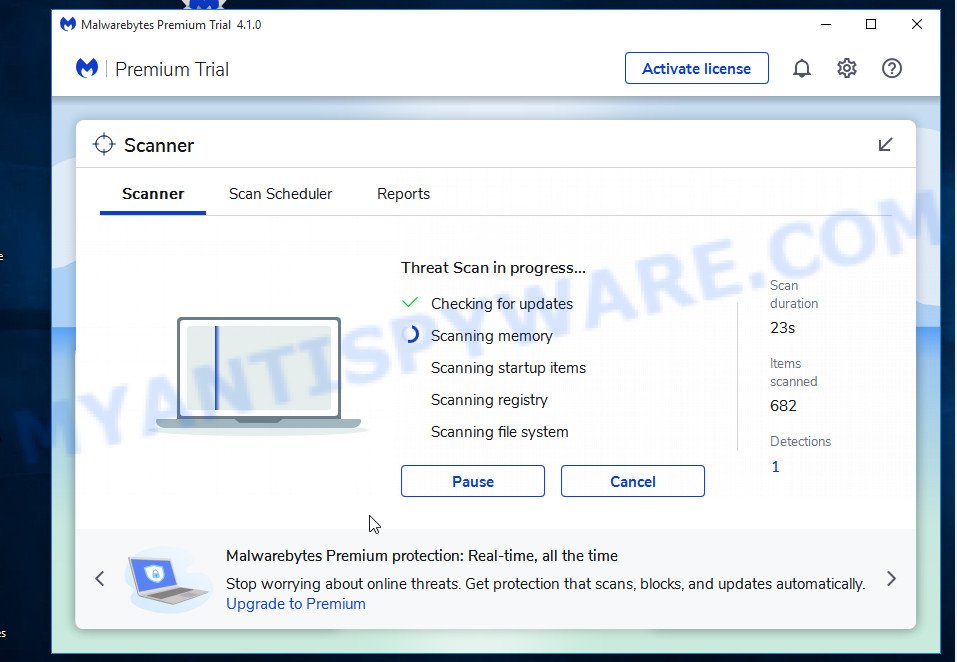
When MalwareBytes is done scanning your computer, MalwareBytes will show you the results. Make sure all items have ‘checkmark’ and click “Quarantine” button. The MalwareBytes Anti Malware (MBAM) will remove adware which causes the annoying Hadchoseitf.work pop-up advertisements. After that process is complete, you may be prompted to restart the computer.

We suggest you look at the following video, which completely explains the process of using the MalwareBytes AntiMalware to remove adware, browser hijacker and other malicious software.
Stop Hadchoseitf.work popups
In order to increase your security and protect your computer against new annoying advertisements and harmful web pages, you need to run adblocker application that blocks an access to harmful advertisements and web pages. Moreover, the program can stop the display of intrusive advertising, which also leads to faster loading of web sites and reduce the consumption of web traffic.
Visit the page linked below to download AdGuard. Save it on your Windows desktop.
26849 downloads
Version: 6.4
Author: © Adguard
Category: Security tools
Update: November 15, 2018
After downloading it, start the downloaded file. You will see the “Setup Wizard” screen such as the one below.

Follow the prompts. After the installation is finished, you will see a window such as the one below.

You can press “Skip” to close the installation program and use the default settings, or press “Get Started” button to see an quick tutorial that will allow you get to know AdGuard better.
In most cases, the default settings are enough and you do not need to change anything. Each time, when you run your PC, AdGuard will start automatically and stop undesired advertisements, block Hadchoseitf.work, as well as other harmful or misleading web pages. For an overview of all the features of the program, or to change its settings you can simply double-click on the AdGuard icon, that can be found on your desktop.
Finish words
Once you have removed the adware using this few simple steps, Microsoft Edge, Google Chrome, Mozilla Firefox and IE will no longer display annoying Hadchoseitf.work web-page when you surf the World Wide Web. Unfortunately, if the guide does not help you, then you have caught a new adware, and then the best way – ask for help.
Please create a new question by using the “Ask Question” button in the Questions and Answers. Try to give us some details about your problems, so we can try to help you more accurately. Wait for one of our trained “Security Team” or Site Administrator to provide you with knowledgeable assistance tailored to your problem with the unwanted Hadchoseitf.work pop up ads.


















